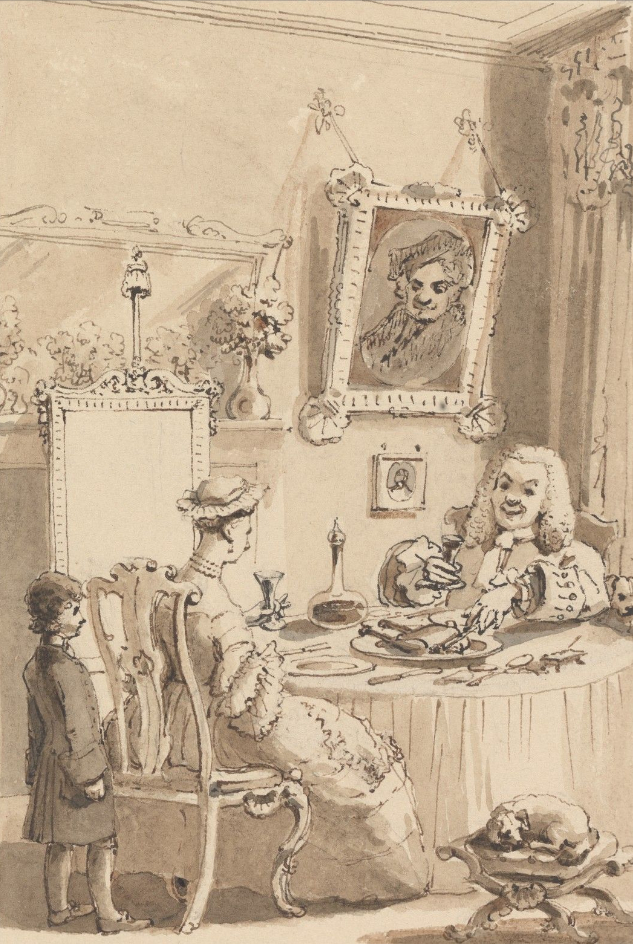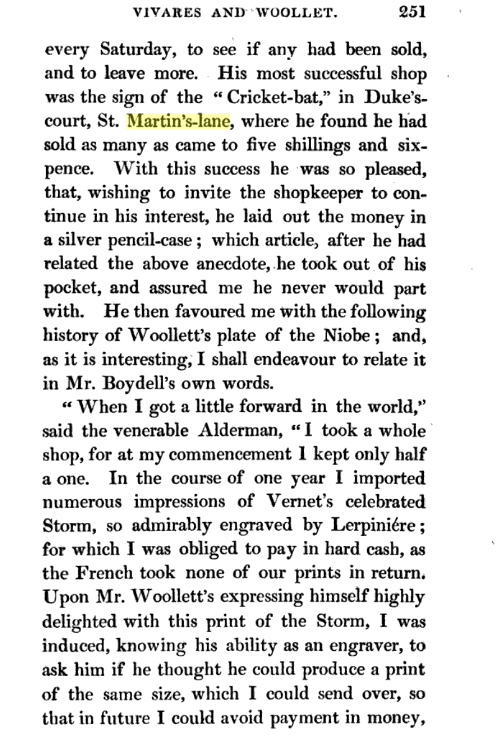John Thomas Smith. (1766 - 1833).
The (Unpublished) Illustrated Life of Hogarth, 1817.
see my posts
https://bathartandarchitecture.blogspot.com/2024/06/john-thomas-smith-perambulation-up-and.html
Nathaniel Smith (1738 - 1809). was the father of JT Smith, he was a former assistant to the sculptor Louis Francois Roubiliac (d. 1762).
He resided and ran his business at the Rembrandt's Head, Great May's Buildings, St.Martin's Lane, London (in 1792-3, 1795, 1797-8). 8 May's Buildings, St Martin's Lane, London.
………..
No 1.
Inscribed in graphite, verso, center: "No 1 | Hogarth
carrying his Master's | sick child round Leicester fields | The Spot of ground
| Leicester house"
………..
No 2.
Inscribed in pen and black ink, upper left: "W H";
inscribed in graphite, verso, center: "No 2. | Hogarth engraving his
Master's | Shop-bills the sign of the Angel"
………..
No 3.
Inscribed in graphite, verso, center: "No 4 | Hogarth
declaring his love | to Miss Thornhill."
Inscribed in graphite, verso, center: "No 5 | Hogarth
after his wife had | put on a new night shift, Ties | up her things to send to
sir James | Thornhill with a letter in which | she told him "He took his
Daughter | without a Smock to her a--e"
.............................
No. 6.
Inscribed in graphite, verso, center: "No 6 | Hogarth
has made breakfast | and sends up a cup to his wife | at the same time ordering
the | little dog to be admitted to her | mistresses bedchamber"
........................................
No. 7.
Inscribed in graphite, verso, center: "No 7 | Hogarth
drinking the first | glass of wine with his wife | ---their dogs keeping |
respectful distances"
........................................
No. 8.
Inscribed in graphite, verso, center: "No 8 | Sir James
Thornhill's boy entering | his Master's painting room to | deliver the bundle
and a letter in | the presence of Lady Thornhill"
....................................
No 9.
Inscribed in graphite, verso, center: "No 9 | The Smock
exposed"
...........................................
No 10.
Inscribed in graphite, verso, center: "No 10 | The
reconsiliation".
...........................
No 11.
Inscribed in graphite, verso, center: "No 11 | Hogarth
drawing Sarah Malcolm".
..................................
No 12.
Inscribed in graphite, verso, center: "No 12 | Hogarth
painting in Vauxhall | gdens in the presence of | Jonathan Tyers"
...................................
No 13.
Inscribed in graphite, verso, center: "No 13 | Hogarth
painting his | picture of Capt Coram for the | Foundling Hospital"
...................................
No 14.
Inscribed in graphite, verso, center: "No 14 | Hogarth
solicits his Patron | Bishop Hoadley to look over | his M.S of "Analysis
of beauty"
..........................................
no 15.
Inscribed in graphite, verso, center: "No 15 | Hogarth
making up a portrait of H. Fielding, | for a Bookseller, from the features of |
Garrick who borrowed one of the Author's | wigs for that particular purpose
there | being no genuine portrait of him".
.......................................
No 16.
Inscribed in graphite, verso, center: "No 16 | Hogarth
painting "The Ladys last stake" | in the presence of Lord
Charlemont."
.................................
No 17.
Inscribed in graphite, verso, center: "No 17 | Hogarth
sitting to Ronbeliac (Roubiliac) for | his Bust".
Note the model of Trump. Smith will have known the bust and model of the dog which had been owned by his father Nathaniel Smith and sold at auction in 1805
Inscribed in graphite, verso, center: "No 18 | Hogarth
at Old Slaughter's | hobbing with Highmore | the painter."
Inscribed in graphite, verso, center: "No 19 | Hogarth
having been followed by | Barry and a friend was caught | backing a boy to
fight-purposely | to catch his fearful countenance".
.................................
No. 20.
Inscribed in graphite, verso, center: "No 20 | The
Eleventh hour".
The author had been a studio-assistant of the sculptor
Joseph Nollekens from 1779 to 1781.
Commercially unsuccessful as a draughtsman and engraver of
London views, he took the post of Keeper of Prints and Drawings at the British
Museum in 1816; and in 1828 published the first edition of this biography. His
account is less an appreciation of the sculptor than a 'warts-and-all'
biography, with anecdotes of the London art-world at the end of the eighteenth
century. (A supplementary account of Nollekens was published by A. Cunningham
in 1830.)
A list of the published works of John Thomas Smith -
JT Smith, Nollekens and his Times. Published London, by Henry Colburn, New Burlington Street, Octr 1828'
A must read for anyone interested in 18th and Early 19th Century Sculpture.
The author had been a studio-assistant of Nollekens from
1779 to 1781. Commercially unsuccessful as a draughtsman and engraver of London
views, he took the post of Keeper of Prints and Drawings at the British Museum
in 1816; and in 1828 published the first edition of this biography. His account
is less an appreciation of the sculptor than a 'warts-and-all' biography, with
anecdotes of the London art-world at the end of the eighteenth century. (A
supplementary account of Nollekens was published by A. Cunningham in 1830.)
Smith, John Thomas, A Book for a Rainy Day or Recollections
of the Events of the Years
Smith, John Thomas, Ancient Topography of London; containing
not only views of buildings, which in many instances no longer exist, and for
the most part were never before published; but some account of places and
customs either unknown, or overlooked by the London Historians, (London: J.
McCreery, 1815).
Smith, John Thomas, Antiquities of London and its Environs;
by John Thomas Smith:
Smith, John Thomas, Antiquities of Westminster; The Old Palace; St Stephen’s Chapel, (Now the House of Commons) &c. &c. Containing Two Hundred and Forty-Six Engravings of Topographical Objects, of which one hundred and twenty-two no longer remain. By John Thomas Smith. This work contains copies of manuscripts which throw new and unexpected light on the ancient history of the Arts in England, (London: T. Bensley, [1800-1807]).
.................
Smith, John Thomas, Tag, Rag and Bob-Tail! being Portraits of Sixteen Notorious Personages, (famous and infamous,) chiefly about Cromwell’s time; Copied, with Accuracy, from very scarce Original Prints; and now First Published; For I. T. Smith [sic].
.......................
The Antiquities of London, (London: J. Jones, 1800).
Smith, John Thomas,
The Cries of London: Exhibiting several of the Itinerant Traders of Antient
[sic] and Modern Times. Copied from Rare Engravings or Drawn from the Life,
with a Memoir and Portrait of the Author, ed. by J. Nichols, (London: John
Bowyer Nichols and Son, 1839).
Smith, John Thomas, Vagabondiana; or, Anecdotes of Mendicant
Wanderers through the Streets of London; with Portraits of the most Remarkable,
Drawn from the Life by John Thomas Smith, Keeper of the Prints in the British
Museum, (London: Published by the Proprietor: and sold by Messrs. J. and A.
Arch, Cornhill; Mr. Hatchard, Bookseller to The Queen, Piccadilly; and Mr.
Clarke, Bond-Street, 1817).
SMITH, John Thomas. Remarks on Rural Scenery with twenty
etchings of cottages, from nature; and some observations and precepts relative
to the pictoresque. June MDCCXCVII. printed [by Joseph Downes] for, and sold by
Nathaniel Smith ancient Print seller at Rembrandts-Head May’s Buildings, St.
Martin’s Lane, and J. T. Smith, at No 40 Frith Street Soho, 1797.





















































